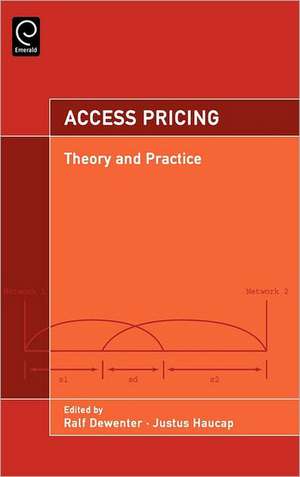Access Pricing – Theory and Practice
Autor Justus Haucap, Ralf Dewenteren Limba Engleză Hardback – 17 sep 2006
The structure of this book which is organized in five parts is as follows: The extended introduction will introduce the key concepts and issues including a brief explanation of the essential facility concept as well as the distinction between one-way and two-way access and will briefly survey the main contributions within the literature on access pricing theory and practice. While parts I and II deal with the theory of one-way and two-way access pricing, respectively, part III focuses on the newly emerging theory of access pricing with multihoming. Parts IV and V address the practice side and focus on industry-specific applications and special problems (Part IV) as well as public policy issues (Part V).
*Provides valuable theoretical and empirical analyses in Access Pricing and related topics
*Offers several different points of view
*Features research from highly reputed scientists working in this field
Preț: 1037.87 lei
Preț vechi: 1347.89 lei
-23% Nou
Puncte Express: 1557
Preț estimativ în valută:
198.62€ • 206.60$ • 163.97£
198.62€ • 206.60$ • 163.97£
Carte tipărită la comandă
Livrare economică 14-28 aprilie
Preluare comenzi: 021 569.72.76
Specificații
ISBN-13: 9780444528032
ISBN-10: 0444528032
Pagini: 492
Dimensiuni: 167 x 238 x 33 mm
Greutate: 0.92 kg
Editura: Emerald Publishing
ISBN-10: 0444528032
Pagini: 492
Dimensiuni: 167 x 238 x 33 mm
Greutate: 0.92 kg
Editura: Emerald Publishing
Public țintă
Economists: Researchers, teachers and graduate students / Universities. Regulatory authorities / Economists and Lawyers, Consultants. Network industries / Economists and Lawyers, Consultants. Antitrust Divisions / Economists and Lawyers, Consultants.Cuprins
Chapter 1
Access Pricing: An Introduction
RALF DEWENTER and JUSTUS HAUCAP
1.Introduction to the Introduction
2.Access to Networks: Concepts and Issues
2.1.Essential Facilities
2.2.One-way Access
2.3.Two-way Access
3.Access Pricing: Theory
4.Access Pricing: Practice
4.1.The Retail-minus Approach
4.2.The Efficient Component Pricing Rule (ECPR)
4.3.Cost-Based Concepts
4.4.Capacity-Based Pricing and Price Caps
4.5.Institutions
5.Contents of this Book: Theory
5.1.One-way Access Pricing
5.2.Two-way Access Pricing
5.3.Access Pricing and Multihoming
6.Contents of this Book: Practice
6.1.Application to Specific Markets
6.2.Policy
7.Conclusion
References
PART I - ONE-WAY ACCESS PRICING
Chapter 2
Access Pricing and Infrastructure Investment
JOSHUA S. GANS
1.Introduction
2.Model of Investment Timing
2.1.Investment costs
2.2.Investment benefits
2.3.Socially optimal timing
3.No Access Regulation
3.1.Motives for access
3.2.Motives for investment
3.3.Negotiations over access
3.4.Equilibrium investment timing
3.5.Summary
4.Access Price Regulation
4.1.“Small” Seekers
4.2.Two “Large” Firms
4.3.Summary
5.Practical Issues
5.1.Optimal usage charges
5.2.Access Holidays
6.Conclusion
References
Chapter 3
Network Financing with Two-Part and Single Tariff
AXEL GAUTIER
1.Introduction
1.1.Model overview and results
1.2.Related literature
2.Model
2.1.Demand, costs, and information
2.2.Regulation
2.3.Timing of the events
2.4.Benchmark: the regulated monopoly case
3.Optimal access charges
3.1.The entrant’s entry and supply decisions
3.2.Two-part tariff
3.3.Single tariff
4.Comparisons
4.1.Market Structure
4.2.Welfare
5.Concluding remarks
A Proof of Propositions
A.1 Proposition 3.2
A.2 Proposition 3.3
A.3 Proposition 4.4
References
Chapter 4
Unbundling the Local Loop: One-way Access and Imperfect Competition
PAUL W. J. DE BIJL and MARTIN PEITZ
1.Introduction
2.Policy on Local-Loop Unbundling in Telecommunications
2.1.Unbundling in the EU
2.2.Unbundling in the US
3.Regulatory Theory with Full Participation
4.Regulatory Theory with Partial Participation
5.Discussion and Conclusion
References
PART II - TWO-WAY ACCESS PRICING
Chapter 5
On the Role of Access Charges under Network Competition
STEFAN BUEHLER and ARMIN SCHMUTZLER
1.Introduction
2.Linear Retail Prices
2.1.Assumptions
2.2.Comparative Statics
2.3.Are Retail Prices Strategic Complements?
2.4.Do Higher Access Charges Shift Out the Reaction Curves?
3.Simplifying Assumptions: How Do They Affect the Role of Access Charges?
3.1.Full Coverage Networks
3.2.Full Coverage Networks and Balanced Calling Pattern
4.Non-linear Retail Tariffs
4.1.Assumptions
4.2.Comparative Statics
5.Extensions and Conclusions
References
Chapter 6
Access Pricing under Cost Asymmetry in Telecommunications
VIKTORIA KOCSIS
1.Introduction
2.Model for linear tariffs
2.1.Cost structure and access fee
2.2.Demand structure and consumer surplus
2.3.Price competition
2.4.Comparison and policy implications
3.Competition in two-part tariffs
3.1.Demand structure and consumer surplus
3.2.Price competition
3.3.Comparison and policy implications
4.Conclusions
A Proofs
B Simulation results
B.1 Comparison according to parameter value
B.2 Comparison according to access fee
References
PART III - ACCESS PRICING AND MULTIHOMING
Chapter 7
Interconnection Competition with Multiple Network Subscription
ROGER K. ALEXANDER
1.Introduction
1.1.Background to New Analysis Framework
1.2.Organization of Paper
2.Consumer Utility Model Setup
2.1.Consumer Discrete Subscription Choice Model
2.2.Direct Measurable Utility from Network Subscription
3.Network Competition - Dual Network Subscriptions
3.1.Network Marginal Costs and Price Competition Model
3.2.Network Calling Pattern
3.3.Two-Stage Network Competition
4.Network Competition Modeling: Linear Pricing
4.1.Equilibrium Price - Access Charge Relationship
5.Conclusion
5.1.Summary and General Findings
5.2.Future Areas of Study
A Dual Network Subscription Example
A.1 Two-Network Model Subscrition Alternatives
A.2 Two-Network Model Subscription Utility
A.3 No Network Subscription
A.4 Subscription to Network 1 Only
A.5 Utility from Subscription to Network 2 Only
A.6 Utility from Subscription to Network 1 AND Network 2
References
Chapter 8
Platform Competition with Endogenous Multihoming
ROBERTO ROSON
1.Introduction
2.The model structure
2.1.Assumptions and definitions
2.2.Profit maximization
3.A numerical simulation of platform competition
4.Concluding remarks
References
PART IV - APPLICATION TO SPECIFIC MARKETS
Chapter 9
Network Ownership and Optimal Tariffs for Natural Gas Transport
KÅRE P. HAGEN, HANS JARLE KIND and JAN GAUTE SANNARNES
1.Introduction
2.A simplified model for transportation of gas
3.Conclusion and Discussion
A Existence of equilibrium
B Downstream competition with firms located outside the country
References
Chapter 10
Mobile Termination
HARLEY THOMPSON, OLIVIER RENARD and JULIAN WRIGHT
1.Introduction
2.Literature review
3.Theoretical model
3.1.Model derivation
3.2.Model solution
4.Model calibration
4.1.Colombian fixed-to-mobile arrangements
4.2.Calibration methodology
4.3.Data for Columbia
5.Welfare analysis
6.Conclusions and future directions
References
Chapter 11
Incentives to Licence Virtual Mobile Network Operators (MVNOs)
RALF DEWENTER and JUSTUS HAUCAP
1.Introduction
2.What are MVNOs?
3.Regulatory Approaches and Emergence of MVNOs
4.The Model
4.1.Cournot Competition
4.2.Bertrand Competition
4.3.Stackelberg Competition
5.Summary and Policy Conclusions
References
PART V - POLICY
Chapter 12
Antitrust and Sector Specific Regulation of Access in th European Union: The Case Electronic Communications
ALEXANDRE DE STREEL
1.Introduction
2.A broad picture
3.Competition Law
3.1.Ex post Competition Law
3.2.Ex ante Competition Law: Mergers and joint ventures
4.Sector Regulation
5.Assessment
5.1.Antitrust
5.2.Sector regulation
5.3.Optimal balance between both instruments
5.4.Optimal institutional co-ordination
6.Conclusion
Appendix
References
Chapter 13
Efficient Regulation of Dynamic Telecommunications Markets and the New Regulatory Framework in Europe
PIO BAAKE, ULRICH KAMECKE and CHRISTIAN WEY
1.Introduction: The new regulatory framework in the European Union
2.Dynamic competition
2.1.Schumpeter’s competition through innovation
2.2.Incentives to innovation
2.3.The role of competition
2.4.Intermediate Conclusion
3.Dynamic competition in telecommunications markets and traditional regulation
3.1.New networks: Structures and demand for DSL accesses
3.2.Investment, downstream markets and strategies for the network operator
3.3.Competition to construct new networks
3.4.Traditional regulation: Cost-based network access
4.Regulation of new markets
4.1.New markets
4.2.Regulation
4.3.Incentive effects: Infrastructure-based competition
5.Summary
References
Chapter 14
Are Vertically Integrated DSL Providers Squeezing Unaffiliated ISPs (and Should We Care)?
ROBERT W. CRANDALL and HAL J. SINGER
1.Introduction
2.The Role of Regulation in Promoting Internet Service Providers
2.1.Computer I and II Decisions
2.2.Choice of Global Service Provider Regulation
2.3.Reciprocal Compensation Game
3.What did Internet Service Contribute to Economic Value?
3.1.The Value-Added of Unaffiliated Internet Service Providers in the Dial-Up Era
3.2.The Value-Added of Intermediaries in the Broadband Era
4.Issues for Competition Law
4.1.Price Squeeze Allegations
4.2.The Conditions under which a Price Squeeze Harms Consumers
4.3.The Relationship between a Price Squeeze and Cross Subsidy
5.Conclusion
References
Access Pricing: An Introduction
RALF DEWENTER and JUSTUS HAUCAP
1.Introduction to the Introduction
2.Access to Networks: Concepts and Issues
2.1.Essential Facilities
2.2.One-way Access
2.3.Two-way Access
3.Access Pricing: Theory
4.Access Pricing: Practice
4.1.The Retail-minus Approach
4.2.The Efficient Component Pricing Rule (ECPR)
4.3.Cost-Based Concepts
4.4.Capacity-Based Pricing and Price Caps
4.5.Institutions
5.Contents of this Book: Theory
5.1.One-way Access Pricing
5.2.Two-way Access Pricing
5.3.Access Pricing and Multihoming
6.Contents of this Book: Practice
6.1.Application to Specific Markets
6.2.Policy
7.Conclusion
References
PART I - ONE-WAY ACCESS PRICING
Chapter 2
Access Pricing and Infrastructure Investment
JOSHUA S. GANS
1.Introduction
2.Model of Investment Timing
2.1.Investment costs
2.2.Investment benefits
2.3.Socially optimal timing
3.No Access Regulation
3.1.Motives for access
3.2.Motives for investment
3.3.Negotiations over access
3.4.Equilibrium investment timing
3.5.Summary
4.Access Price Regulation
4.1.“Small” Seekers
4.2.Two “Large” Firms
4.3.Summary
5.Practical Issues
5.1.Optimal usage charges
5.2.Access Holidays
6.Conclusion
References
Chapter 3
Network Financing with Two-Part and Single Tariff
AXEL GAUTIER
1.Introduction
1.1.Model overview and results
1.2.Related literature
2.Model
2.1.Demand, costs, and information
2.2.Regulation
2.3.Timing of the events
2.4.Benchmark: the regulated monopoly case
3.Optimal access charges
3.1.The entrant’s entry and supply decisions
3.2.Two-part tariff
3.3.Single tariff
4.Comparisons
4.1.Market Structure
4.2.Welfare
5.Concluding remarks
A Proof of Propositions
A.1 Proposition 3.2
A.2 Proposition 3.3
A.3 Proposition 4.4
References
Chapter 4
Unbundling the Local Loop: One-way Access and Imperfect Competition
PAUL W. J. DE BIJL and MARTIN PEITZ
1.Introduction
2.Policy on Local-Loop Unbundling in Telecommunications
2.1.Unbundling in the EU
2.2.Unbundling in the US
3.Regulatory Theory with Full Participation
4.Regulatory Theory with Partial Participation
5.Discussion and Conclusion
References
PART II - TWO-WAY ACCESS PRICING
Chapter 5
On the Role of Access Charges under Network Competition
STEFAN BUEHLER and ARMIN SCHMUTZLER
1.Introduction
2.Linear Retail Prices
2.1.Assumptions
2.2.Comparative Statics
2.3.Are Retail Prices Strategic Complements?
2.4.Do Higher Access Charges Shift Out the Reaction Curves?
3.Simplifying Assumptions: How Do They Affect the Role of Access Charges?
3.1.Full Coverage Networks
3.2.Full Coverage Networks and Balanced Calling Pattern
4.Non-linear Retail Tariffs
4.1.Assumptions
4.2.Comparative Statics
5.Extensions and Conclusions
References
Chapter 6
Access Pricing under Cost Asymmetry in Telecommunications
VIKTORIA KOCSIS
1.Introduction
2.Model for linear tariffs
2.1.Cost structure and access fee
2.2.Demand structure and consumer surplus
2.3.Price competition
2.4.Comparison and policy implications
3.Competition in two-part tariffs
3.1.Demand structure and consumer surplus
3.2.Price competition
3.3.Comparison and policy implications
4.Conclusions
A Proofs
B Simulation results
B.1 Comparison according to parameter value
B.2 Comparison according to access fee
References
PART III - ACCESS PRICING AND MULTIHOMING
Chapter 7
Interconnection Competition with Multiple Network Subscription
ROGER K. ALEXANDER
1.Introduction
1.1.Background to New Analysis Framework
1.2.Organization of Paper
2.Consumer Utility Model Setup
2.1.Consumer Discrete Subscription Choice Model
2.2.Direct Measurable Utility from Network Subscription
3.Network Competition - Dual Network Subscriptions
3.1.Network Marginal Costs and Price Competition Model
3.2.Network Calling Pattern
3.3.Two-Stage Network Competition
4.Network Competition Modeling: Linear Pricing
4.1.Equilibrium Price - Access Charge Relationship
5.Conclusion
5.1.Summary and General Findings
5.2.Future Areas of Study
A Dual Network Subscription Example
A.1 Two-Network Model Subscrition Alternatives
A.2 Two-Network Model Subscription Utility
A.3 No Network Subscription
A.4 Subscription to Network 1 Only
A.5 Utility from Subscription to Network 2 Only
A.6 Utility from Subscription to Network 1 AND Network 2
References
Chapter 8
Platform Competition with Endogenous Multihoming
ROBERTO ROSON
1.Introduction
2.The model structure
2.1.Assumptions and definitions
2.2.Profit maximization
3.A numerical simulation of platform competition
4.Concluding remarks
References
PART IV - APPLICATION TO SPECIFIC MARKETS
Chapter 9
Network Ownership and Optimal Tariffs for Natural Gas Transport
KÅRE P. HAGEN, HANS JARLE KIND and JAN GAUTE SANNARNES
1.Introduction
2.A simplified model for transportation of gas
3.Conclusion and Discussion
A Existence of equilibrium
B Downstream competition with firms located outside the country
References
Chapter 10
Mobile Termination
HARLEY THOMPSON, OLIVIER RENARD and JULIAN WRIGHT
1.Introduction
2.Literature review
3.Theoretical model
3.1.Model derivation
3.2.Model solution
4.Model calibration
4.1.Colombian fixed-to-mobile arrangements
4.2.Calibration methodology
4.3.Data for Columbia
5.Welfare analysis
6.Conclusions and future directions
References
Chapter 11
Incentives to Licence Virtual Mobile Network Operators (MVNOs)
RALF DEWENTER and JUSTUS HAUCAP
1.Introduction
2.What are MVNOs?
3.Regulatory Approaches and Emergence of MVNOs
4.The Model
4.1.Cournot Competition
4.2.Bertrand Competition
4.3.Stackelberg Competition
5.Summary and Policy Conclusions
References
PART V - POLICY
Chapter 12
Antitrust and Sector Specific Regulation of Access in th European Union: The Case Electronic Communications
ALEXANDRE DE STREEL
1.Introduction
2.A broad picture
3.Competition Law
3.1.Ex post Competition Law
3.2.Ex ante Competition Law: Mergers and joint ventures
4.Sector Regulation
5.Assessment
5.1.Antitrust
5.2.Sector regulation
5.3.Optimal balance between both instruments
5.4.Optimal institutional co-ordination
6.Conclusion
Appendix
References
Chapter 13
Efficient Regulation of Dynamic Telecommunications Markets and the New Regulatory Framework in Europe
PIO BAAKE, ULRICH KAMECKE and CHRISTIAN WEY
1.Introduction: The new regulatory framework in the European Union
2.Dynamic competition
2.1.Schumpeter’s competition through innovation
2.2.Incentives to innovation
2.3.The role of competition
2.4.Intermediate Conclusion
3.Dynamic competition in telecommunications markets and traditional regulation
3.1.New networks: Structures and demand for DSL accesses
3.2.Investment, downstream markets and strategies for the network operator
3.3.Competition to construct new networks
3.4.Traditional regulation: Cost-based network access
4.Regulation of new markets
4.1.New markets
4.2.Regulation
4.3.Incentive effects: Infrastructure-based competition
5.Summary
References
Chapter 14
Are Vertically Integrated DSL Providers Squeezing Unaffiliated ISPs (and Should We Care)?
ROBERT W. CRANDALL and HAL J. SINGER
1.Introduction
2.The Role of Regulation in Promoting Internet Service Providers
2.1.Computer I and II Decisions
2.2.Choice of Global Service Provider Regulation
2.3.Reciprocal Compensation Game
3.What did Internet Service Contribute to Economic Value?
3.1.The Value-Added of Unaffiliated Internet Service Providers in the Dial-Up Era
3.2.The Value-Added of Intermediaries in the Broadband Era
4.Issues for Competition Law
4.1.Price Squeeze Allegations
4.2.The Conditions under which a Price Squeeze Harms Consumers
4.3.The Relationship between a Price Squeeze and Cross Subsidy
5.Conclusion
References













